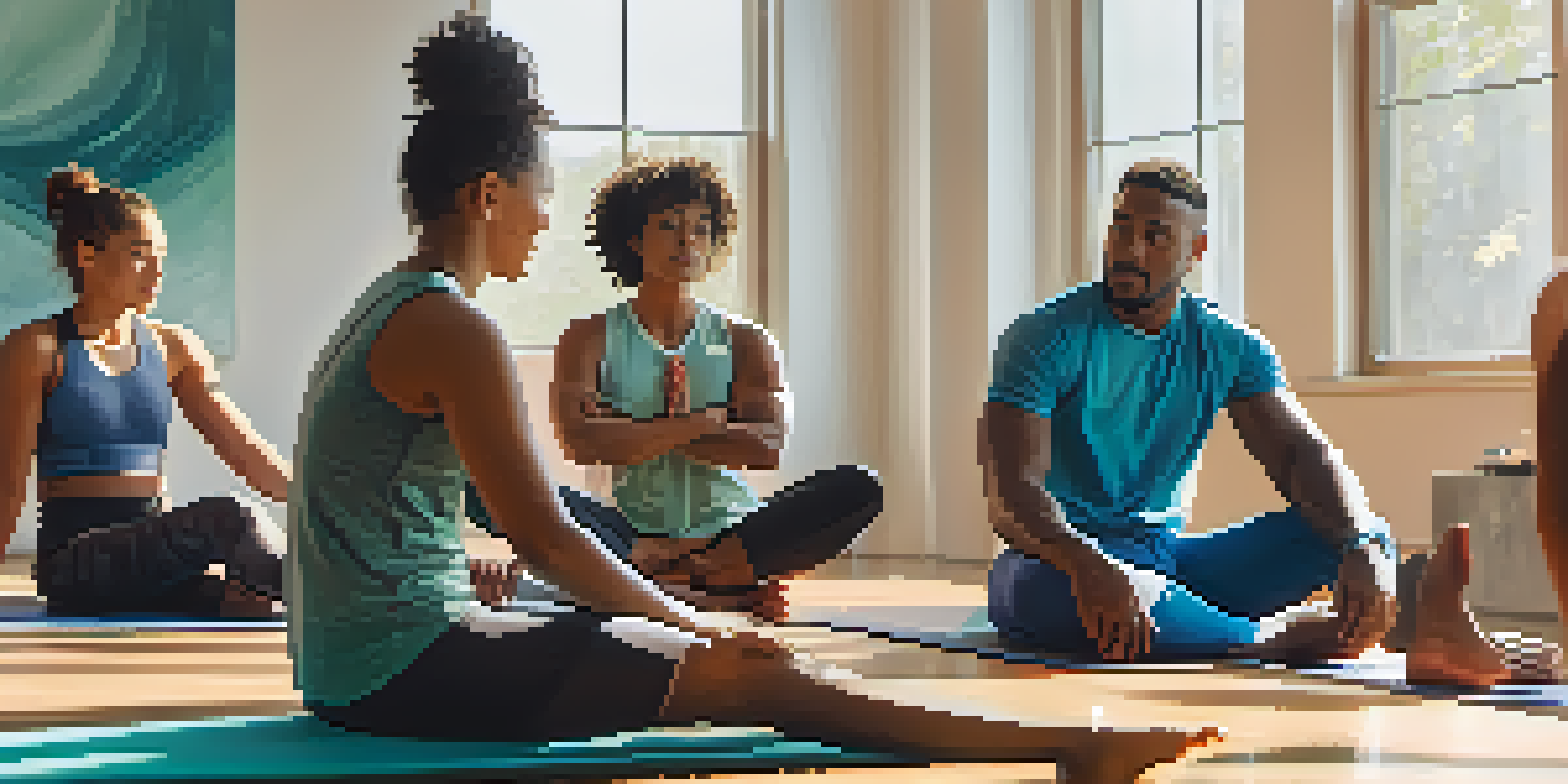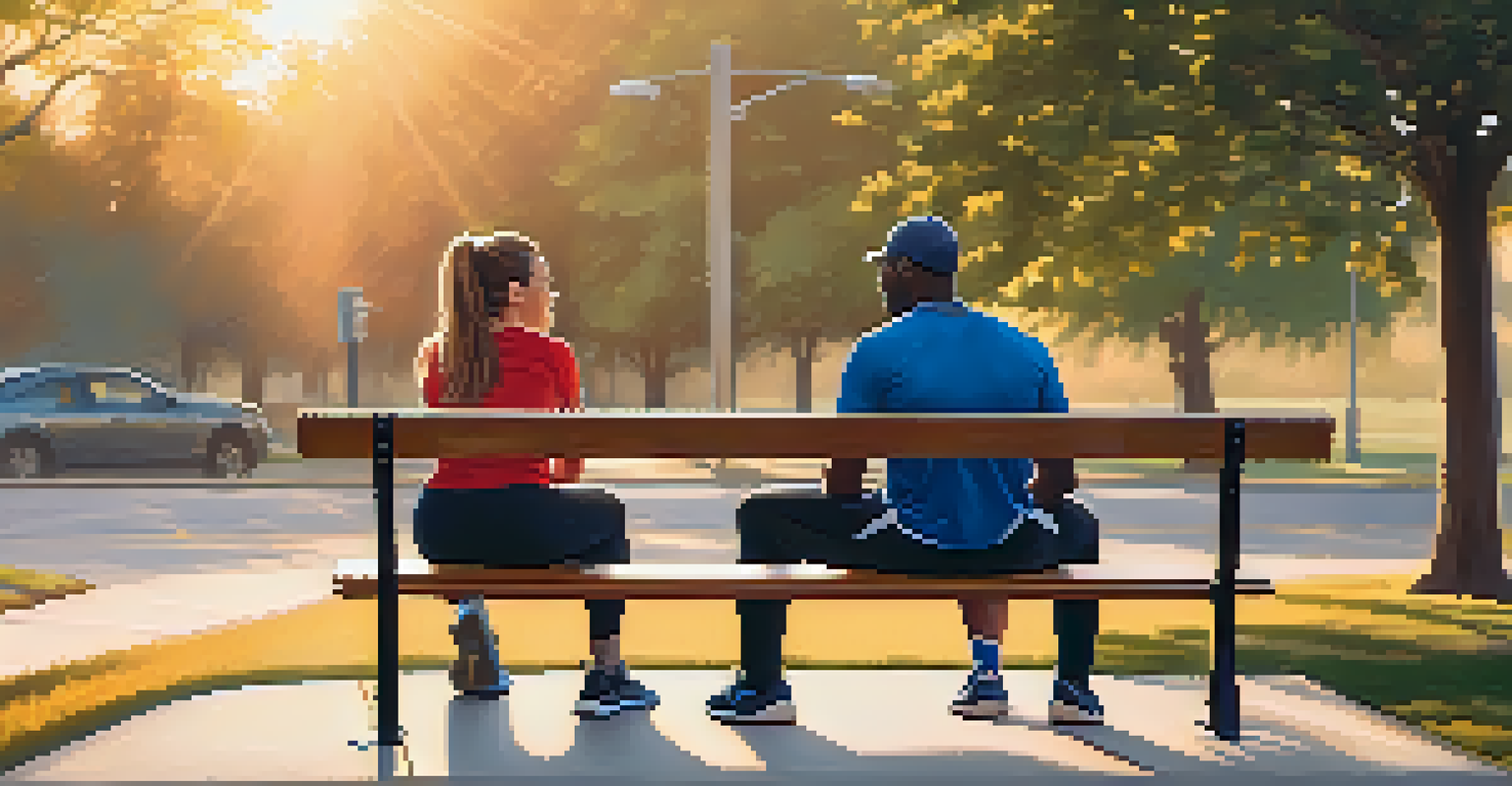The Role of Peer Support in Athlete Rehabilitation Process

Understanding Peer Support in Sports Rehabilitation
Peer support refers to the emotional and practical assistance provided by fellow athletes during the recovery process. This type of support can take many forms, from sharing experiences to encouraging each other through challenges. By fostering a sense of community, athletes can feel less isolated in their journey back to health.
Alone, we can do so little; together, we can do so much.
In the world of sports, rehabilitation is not just about physical recovery; it's also about mental resilience. When athletes engage with peers who have faced similar setbacks, it helps normalize their feelings and experiences. This shared understanding can be incredibly powerful, often leading to a more positive outlook on recovery.
Ultimately, the role of peer support in rehabilitation is about building a network of encouragement and understanding. As athletes navigate the ups and downs of recovery, having someone who truly 'gets it' can make a world of difference. It's this camaraderie that helps athletes push through difficult moments and stay motivated.
Benefits of Peer Support for Athletes
One of the most significant benefits of peer support is the emotional boost it provides. Athletes often face intense pressure to perform, and an injury can feel like a significant setback. However, connecting with peers who have overcome similar challenges can inspire hope and determination.

Moreover, peer support can enhance accountability. When athletes engage with one another, they are more likely to stick to their rehabilitation programs. This dynamic creates a sense of responsibility, where each athlete encourages the other to stay committed and focused on their goals.
Peer Support Boosts Recovery
Emotional and practical assistance from fellow athletes fosters resilience and enhances the rehabilitation experience.
Additionally, the shared experiences of recovery can lead to valuable insights. Peers can exchange advice on what worked for them and what didn’t, creating a rich repository of knowledge. This collaborative learning fosters a culture of support and empowerment, vital for a successful rehabilitation journey.
Building a Supportive Environment
Creating a supportive environment is crucial for maximizing the benefits of peer support. Coaches and sports organizations can play a key role in establishing this culture by encouraging open communication and connection among athletes. By facilitating group activities or discussions, they can help athletes bond over shared experiences.
In the middle of every difficulty lies opportunity.
Moreover, it's important to recognize that not all athletes will feel comfortable seeking support. Some may need encouragement to open up about their struggles. Implementing programs that promote mental health awareness can help athletes feel safe and understood when reaching out to peers.
Ultimately, fostering a supportive environment not only aids in rehabilitation but also strengthens the overall team dynamic. Athletes who feel supported by their peers are more likely to thrive, both on and off the field, creating a positive atmosphere for everyone involved.
Peer Support vs. Professional Guidance
While peer support is invaluable, it's essential to remember that it complements professional guidance rather than replaces it. Healthcare professionals bring expertise and structured rehabilitation programs that are crucial for recovery. Peer support, on the other hand, adds a layer of emotional and social assistance that can enhance the overall experience.
Both elements work best when integrated seamlessly into the rehabilitation process. For instance, athletes can discuss their professional treatment plans with peers, gaining insights and encouragement from those who have been through similar experiences. This collaboration creates a holistic approach to healing.
Supportive Environments Matter
Creating a culture of open communication and connection among athletes maximizes the benefits of peer support.
Understanding the distinction between peer support and professional guidance allows athletes to make the most of both resources. By leveraging the strengths of each, athletes can achieve a more well-rounded recovery, addressing both their physical and emotional needs.
Success Stories: Peer Support in Action
Real-life success stories often illustrate the power of peer support in rehabilitation. Consider an athlete who faced a long recovery from surgery; through regular check-ins and shared workouts with teammates, they found the motivation to stay on track. This sense of belonging and encouragement helped them return to their sport stronger than ever.
These stories not only inspire others but also highlight the tangible benefits of peer support. Athletes who have experienced support from their peers often cite increased confidence and a more positive mindset as key factors in their recovery. Sharing these narratives can create a ripple effect, encouraging more athletes to seek and offer support.
By celebrating success stories, we can further emphasize the importance of community in the rehabilitation process. Each narrative serves as a testament to how athletes can uplift one another, reinforcing the idea that no one has to face their challenges alone.
Challenges in Peer Support Dynamics
Despite its many benefits, peer support can also come with challenges. Not all peer relationships are positive, and sometimes, competition or jealousy can arise, especially in high-stakes environments. It’s essential for athletes to navigate these dynamics carefully, ensuring that support remains constructive and uplifting.
Additionally, athletes may struggle with vulnerability when reaching out for help. The stigma associated with perceived weakness can prevent them from engaging fully with their peers. Encouraging open dialogue about mental health and the importance of support can help break down these barriers.
Balancing Peer and Professional Help
Integrating peer support with professional guidance creates a holistic approach to recovery, addressing both physical and emotional needs.
Addressing these challenges is vital for fostering effective peer support systems. By promoting a culture of empathy and understanding, athletes can create a more inclusive environment where everyone feels empowered to share their struggles and successes.
The Future of Peer Support in Sports Rehabilitation
Looking ahead, the role of peer support in sports rehabilitation is likely to grow even more significant. As awareness of mental health and well-being continues to rise, more athletes and organizations are recognizing the importance of community in recovery. This shift will encourage the development of more structured peer support programs.
Technology also plays a crucial role in this evolution. Online platforms and social media can facilitate connections among athletes, allowing them to share their journeys and support one another, regardless of geographical barriers. Virtual support groups can provide a valuable outlet for those who may feel isolated during recovery.

Ultimately, the future of peer support in sports rehabilitation looks promising. As we continue to learn from each other and build supportive networks, athletes will likely experience improved recovery outcomes and a renewed sense of camaraderie in their sports communities.